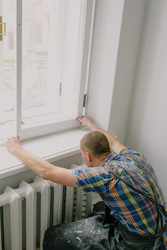Debunking Common Misconceptions about Silicone Sealant
Apr 18th 2023
Although the words “silicone sealant” is a word familiar to most contractors, the average customer may know very little. The term silicone may pop up in textbooks, hardware stores, product descriptions, and even skin-care, but there are still a lot of myths about silicone sealants. Few understand its properties, and the many different ways to use it.
It’s fine for customers not to know the nitty-gritty details on all the different types of polymer sealants. But as a contractor or construction professional, it’s important to know the truth about common misconceptions.
Knowing the wrong information about silicone materials could result in results that don’t last, and therefore unhappy customers. We’ve read and debunked some of the top common misconceptions about silicone sealants. The next time you hear a coworker or customer make any of these statements, show them this article!
X Myth: There’s just one type of silicone sealant.
✓Fact: There are many different varieties of silicone sealant.
Keeping track of all all the differerent types of sealant straight can be difficult, even if you are a seasoned worker. There are three types of main silicone sealants: high modulus acetoxy, low modulus acetoxy, and low modulus neutral. Each of these are best for certain uses.
- High modulus acetoxy:
Ideal for indoor sealing around the bathroom and kitchen area, high-modulus acetoxy sealants cure quickly and form a rigid seal. They can also be used on and around baths, showers, tile, and glass. A good sealant in this category will be mildew-resistant, since it’s usually applied to moisture-prone areas.
- Low modulus neutral:
Products like our Select Neutral Cure 100% RTV Silicone Sealant are best for outdoor use because it has more of a weatherproof, flexible seal. It can be used on a wide variety of materials, and it’s one of the only silicone sealants that works on vinyl.
- Low modulus acetoxy:
This type of sealant is excellent if you need a good all around sealant. It works well for buildings, sanitary sealing, and glazing exteriors. However, it doesn’t give the same strength and durability you might find with certain specialized silicone sealants. Our Premium 100% RTV Silicone Sealant can get most jobs done, but if you are working with vinyl, coated guttering applications, concrete, stone, or masonry, neutral-cure is a better fit.
X Myth: Silicone sealant is for home use only.
✓Fact: Silicone sealant is useful for a wide variety of uses, ranging from crafts, aquariums, and essential construction processes.
Your customers may be surprised to learn that they can even benefit from owning a tube of silicone sealant. It’s often used in food and cooking utensils, aquariums, vehicle repair, and even in DIY crafts! It’s also an essential material for construction workers used for sealing buildings, highway expansion joints, weatherproofing structures and fixtures, and even coating wires in walls and ceilings.
Silicone sealants are also used in the process of structural glazing, where the cured sealant becomes part of a building’s overall structure and design. Structural silicone glazing (SSG) is the process of bonding together glass, ceramic, metal, stone, and composite panels to the frame of the building, which is made possible by the sealant’s flexibility, strength, and durability. The Burj-Al-Arab, a 7-star hotel in Dubai, is one breathtaking example of this process.
X Myth: Silicone sealant is Toxic
✓Fact: Silicone sealant isn’t harmful to humans once cured.
Although you shouldn’t down silicone sealant with your next meal, it’s completely non-toxic once it’s cured. In fact, silicone sealant is so safe that it’s often used in cooking tools and utensils. However, that doesn’t mean you shouldn’t use all safety precautions. The acextoxy in silicone sealant can let off strong fumes and cause lightheadedness, so always work in a well-ventilated area when using silicone sealant.
Some people may also have allergic reactions or eye irritation to the sealant before its cured. It’s always a good idea to use safety best practices so avoid this, such as wearing goggles and washing your hands after use. If you need detailed information about the safety of a specific product, you can easily find the safety sheet on any of our product pages.
X Myth: Silicone sealant looks ugly.
✓Fact: Silicone sealant can add to the aesthetics of a building.
Contrary to popular belief, not every silicone sealant is a gross, off-white color smeared over cracks or gaps. With the help of a quality sealant and a skilled hand, silicone sealant can completely blend into the look of a building or home.
Part of avoiding an ugly-looking application of sealant is knowing how to apply it the right way. (use proper caulking to not use too much, link to article) Although you can’t paint over silicone sealant, it’s available in a wide variety of colors, from red, blue, white, black, clear, and more. You can easily find a color to match the surface you’re working on, or just go with a clear sealant to make the application discrete.
X Myth: Silicone sealant is too expensive.
✓Fact: Silicone Depot offers silicone sealant at the best prices and the highest quality!
Without a doubt, silicone sealant is one of the top materials for contractors. Its durability, flexibility, and wide range of uses make it a staple for home renovators, handymen, and construction professionals. But with prices everywhere getting higher and higher, it’s getting more difficult to find affordable silicone sealant for contractors without sacrificing quality.
Luckily, Silicone Depot has you covered. We offer a wide range of products, including automotive sealant, food-safe silicone sealant, concrete joint expansion sealant, spray foam, caulking guns, and more. Our products are available in single amounts or in bulk, with discounts available and free shipping on orders over $35. To find the best construction materials for your next big project, shop at Silicone Depot today!

